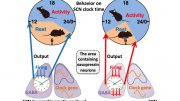
Scientists have employed mathematical models to understand the impact of disruptions on circadian rhythms, discovering that even minor disturbances can enhance neuron connections in the brain’s master clock.
Understanding Circadian Rhythm Disruptions Through Mathematical Models
Researchers are using mathematical models to gain insights into the impacts of various disruptions on the body’s circadian rhythms. These disruptions include daylight savings time, night shift work, jet lag, and late-night phone usage.
Scientists from the University of Waterloo and the University of Oxford have developed a new model to help scientists better understand the resilience of the brain’s master clock: the cluster of neurons in the brain that coordinates the body’s other internal rhythms. They also hope to suggest ways to help improve this resilience in individuals with weak or impaired circadian rhythms.
Persistent disruptions to circadian rhythm are associated with health conditions, including diabetes, memory loss, and many other disorders.
The Effects of Modern Lifestyles on Circadian Rhythms
“Current society is experiencing a rapid increase in demand for work outside of traditional daylight hours,” said Stéphanie Abo, a PhD student in applied mathematics and the study’s lead author. “This greatly disrupts how we are exposed to light, as well as other habits such as eating and sleeping patterns.”
Humans’ circadian rhythms, or internal clocks, are the roughly 24-hour cycles many body systems follow, usually alternating between wakefulness and rest. Scientists are still working to understand the cluster of neurons known as Suprachiasmatic Nucleus (SCN) or master clock.
Methodology and Key Findings
By employing mathematical modeling techniques and differential equations, the research team of applied mathematics researchers modeled the SCN as a macroscopic, or big-picture, system comprised of a seemingly infinite number of neurons. They were especially interested in understanding the system’s couplings – the connections between neurons in the SCN that allow it to achieve a shared rhythm.
Frequent and sustained disturbances to the body’s circadian rhythms eliminated the shared rhythm, implying a weakening of the signals transmitted between SCN neurons.
Abo said they were surprised to find that “a small enough disruption can actually make the connections between neurons stronger.”
“Mathematical models allow you to manipulate body systems with specificity that cannot be easily or ethically achieved in the body or a petri dish,” Abo said. “This allows us to do research and develop good hypotheses at a lower cost.”
Reference: “Can the Clocks Tick Together Despite the Noise? Stochastic Simulations and Analysis” by Stéphanie M.C. Abo, José A. Carrillo and Anita T. Layton, 7 June 2023, SIAM Journal on Applied Dynamical Systems.
DOI: 10.1137/22M147788X








Be the first to comment on "Rhythms on the Rocks: How Modern Life Disrupts Our Internal Clocks"